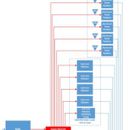Converting gravity to pumped and adding radiators – a few questions
I am looking to upgrade a very old system and have picked up a LOT of information from GBA. But I have a few more questions.
Current situation:
I have a 100+ year old boiler (for real – coal converted to gas a long time ago) with five cast iron radiators fed by a gravity system on a single floor.
Proposed situation:
I’d like to add five small panel radiators to supply supplemental heat to a few areas that are unheated. Three of the new radiators will be on the floor with the existing cast iron radiators. Two would be on a second floor (previously unheated). I would like the new panel radiators to have TRVs to prevent the possibility of overheating in their areas. I expect that the existing radiators would represent about 75% of the heating load and the new ones about 25%.
Questions:
1. I assume that given the complexities – I will need to move to a pumped system. I would be adding radiators on a new upper floor that was previously not part of the gravity system. The new radiators would be below the existing (open) expansion tank. Is this assumption correct?
2. Assuming I converted to a pumped PEX system (with home runs to each radiator), I would like to install TRVs on the new radiators and leave the existing cast iron radiators without TRVs. Good or bad idea?
3. Can this system be fit with an efficient variable speed circulator? Do I need a bypass considering the old radiators would always be passing flow (and are in the zone where the main thermostat is located)?
4. Would I need a buffer tank if I wanted to install a condensing boiler?
I appreciate in advance any feedback. I am leery of trusting HVAC contractors as the last one I called didn’t even know how to service a boiler as old as mine – took one look at it and said it needed to be replaced immediately for $5k.
Also, I am a mechanical engineer (without residential experience) so don’t be afraid to get technical with me.
Andrew
GBA Detail Library
A collection of one thousand construction details organized by climate and house part










Replies
Even a well-maintained and refurbished gas-fired boiler designed for a gravity feed system probably has a combustion efficiency under 60%, and is probably oversized to the point that its as-used AFUE is under 50%. The contractor recommending a swap-out for a new cast-iron beastie (at ONLYUSD $5K???) wasn't necessarily steering you wrong, but it's right to be a bit leery.
With the very high thermal mass of the water in the existing heating system plumbing and high volume radiators you won't necessarily need to add a buffer tank to use a condensing boiler even if you micro-zone it. The fat plumbing becomes your much longer if somewhat skinny buffer tank, so keeping as much fat plumbing as possible between the supply and return manifolds makes a significant difference, particularly for your low thermal mass panel radiator micro-zones. But it's important to right-size the boiler for the whole-house heat load, and pay attention to the total thermal mass between the boiler and radiation on any given micro-zone, and the amount of radiation on each micro-zone.
Everything starts with a room-by-room, zone by zone Manual-J load calculation.
A napkin-math sketch of where to start thinking about it can be found here, but it's probably worth hiring a competent hydronic designer before diving in, since there are many trade-offs to be made in any real system:
https://www.greenbuildingadvisor.com/blogs/dept/guest-blogs/sizing-modulating-condensing-boiler
Dana,
Thanks for the quick response. Any guidance on adding new radiators without a new boiler? I assume I would have to convert to a pumped system and obviously, TRVs would be out of the question.
I have looked at the link you provided and figured out a rough boiler size. When I get home I am going to calculate radiator capacities to make sure I can stay within the boiler modulation range.
It's hard to say for sure what's the right approach if you're not swapping out the boiler. Depending on just how thermally massive the system is, you can probably find a place to tap in on the main supply and main return, and only pump the low-mass micro-zones at some low flow (say 0.5-1 gpm) and let the existing system continue to operate un-pumped as it was designed.
The pumping will slow, but is unlikely to reverse the flow on the convective gravity loop, as long as you're very modest in your flow rates. Don't just drop a Taco 007 on it- use an ECM drive smart pump that has some control options to ensure that the new zones aren't being over-pumped.